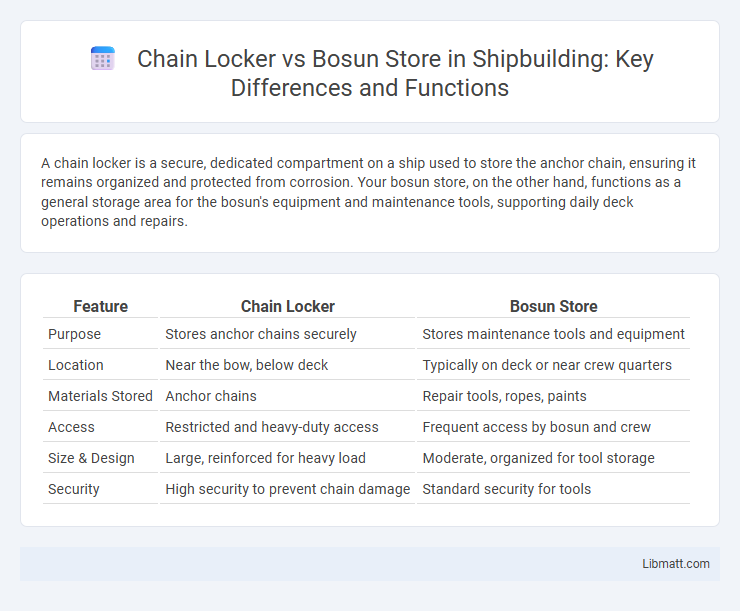A chain locker is a secure, dedicated compartment on a ship used to store the anchor chain, ensuring it remains organized and protected from corrosion. Your bosun store, on the other hand, functions as a general storage area for the bosun's equipment and maintenance tools, supporting daily deck operations and repairs.
Table of Comparison
| Feature | Chain Locker | Bosun Store |
|---|---|---|
| Purpose | Stores anchor chains securely | Stores maintenance tools and equipment |
| Location | Near the bow, below deck | Typically on deck or near crew quarters |
| Materials Stored | Anchor chains | Repair tools, ropes, paints |
| Access | Restricted and heavy-duty access | Frequent access by bosun and crew |
| Size & Design | Large, reinforced for heavy load | Moderate, organized for tool storage |
| Security | High security to prevent chain damage | Standard security for tools |
Introduction to Chain Lockers and Bosun Stores
Chain lockers are secure compartments located at the bow of a ship, designed specifically for storing anchor chains and preventing damage or tangling. Bosun stores, on the other hand, serve as general storage areas for deck equipment, tools, and maintenance supplies crucial for daily operations and repairs. Understanding the distinct purposes and locations of your chain locker and bosun store helps ensure efficient ship management and safety.
Purpose and Function of Chain Lockers
A chain locker is a specialized storage compartment on a ship designed specifically to store the anchor chain securely, preventing tangling and damage. It is typically located near the bow to facilitate smooth deployment and retrieval of the anchor, ensuring the ship's anchoring system functions efficiently. Your understanding of the chain locker's purpose is crucial for maintaining proper anchor management and safety on board.
Overview of Bosun Stores on Ships
Bosun stores on ships typically serve as specialized storage areas for equipment related to the deck department, including ropes, tools, and maintenance supplies essential for ship operations. Unlike chain lockers, which are primarily designed for the secure stowage of anchor chains, bosun stores provide organized access to various spares and deck gear you need for ship maintenance and repairs. Efficient management of bosun stores enhances operational readiness and ensures quick retrieval of essential deck equipment during voyages.
Key Differences Between Chain Lockers and Bosun Stores
Chain lockers primarily serve as storage compartments for heavy anchor chains, positioned near the bow of a ship to facilitate anchor handling, while bosun stores hold maintenance and repair equipment used by the bosun and crew. Chain lockers are designed with reinforced, watertight construction to contain chains and prevent water ingress, whereas bosun stores offer organized space for tools, spare parts, and safety gear critical for ship upkeep. Understanding these distinctions helps ensure Your vessel's operational efficiency and safety by optimizing storage based on function and accessibility.
Construction and Design Features
The chain locker is a watertight compartment located at the bow of a ship designed specifically to store anchor chains; it features reinforced steel walls and drainage systems to handle the weight and corrosion of heavy chains. The bosun store, usually situated near the deck, is constructed as a secure storage room for tools, spare parts, and maintenance equipment, with shelving and locking mechanisms optimized for easy access and inventory management. Chain lockers prioritize structural strength and moisture resistance, whereas bosun stores focus on organization and protection of various shipboard supplies.
Safety Considerations in Chain Lockers and Bosun Stores
Chain lockers and bosun stores both require stringent safety measures to prevent accidents and ensure secure storage of maritime equipment. Proper ventilation, regular inspection for rust or corrosion, and secure locking mechanisms are essential in chain lockers to avoid hazards such as chain jamming or accidental injuries. Your crew's safety also depends on well-organized bosun stores, where clear labeling and safe stacking of tools minimize the risk of falling objects or tripping hazards during routine maintenance.
Storage Practices and Organization
Chain lockers are specifically designed compartments on a ship for securely storing heavy anchor chains, featuring reinforced construction and drainage systems to prevent rust and tangling. Bosun stores serve as general-purpose storage areas for deck equipment, tools, and maintenance supplies, organized with shelving and bins to ensure quick access and inventory control. Your ship's storage efficiency improves by allocating chain lockers solely for anchor chains while using bosun stores to keep essential deck gear systematically arranged.
Maintenance Requirements
Chain lockers require regular cleaning and inspection to prevent corrosion and damage from saltwater exposure, ensuring anchor chains remain functional and free of debris. Bosun stores, used for storing tools and spare equipment, demand consistent organization and inventory checks to maintain readiness and avoid equipment loss. Both facilities benefit from routine maintenance to uphold safety standards and operational efficiency on board.
Common Issues and Troubleshooting
Common issues with a chain locker include corrosion, chain jamming, and water accumulation, which can hinder effective anchor deployment and retrieval. Bosun store problems often involve inventory mismanagement, tool damage, and limited space affecting maintenance efficiency. To troubleshoot, regularly inspect and clean the chain locker to prevent rust and blockage, while organizing and inventory-checking the bosun store ensures that your tools are readily available and in good condition.
Best Practices for Shipboard Storage Spaces
Chain lockers and bosun stores serve distinct purposes in shipboard storage, with chain lockers designed specifically for securing anchor chains and bosun stores allocated for general hardware and maintenance tools. Best practices recommend maintaining the chain locker free of debris and water buildup to prevent corrosion and ensure smooth anchor operation, while bosun stores should be organized with labeled compartments for quick access to essential equipment. Proper ventilation, regular inspections, and adherence to safety protocols in both storage areas optimize shipboard efficiency and prolong the lifespan of stored items.
Chain locker vs bosun store Infographic

 libmatt.com
libmatt.com